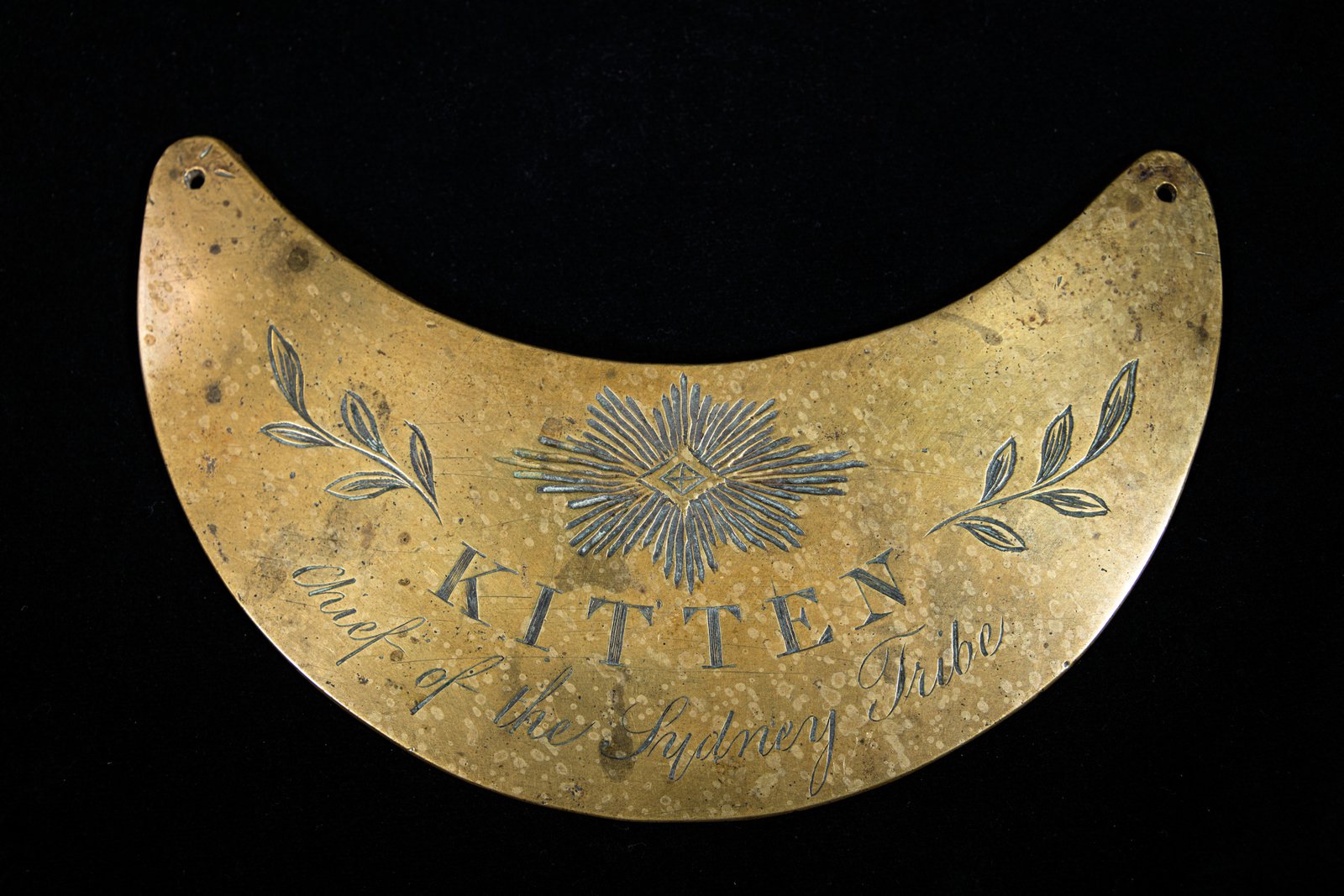Breastplates
On this page...
Curators’ acknowledgement
“We pay our respects and dedicate the Unsettled exhibition to the people and other Beings who keep the law of this land; to the Elders and Traditional Owners of all the knowledges, places, and stories in this exhibition; and to the Ancestors and Old People for their resilience and guidance.
We advise that there are some confronting topics addressed in this exhibition, including massacres and genocide. Aboriginal and Torres Strait Islander peoples should be advised that there may be images of people who have passed away.”
Laura McBride and Dr Mariko Smith, 2021.
Breastplates
While acts of outright warfare were committed as part of the process of colonisation, attempts at diplomatic relations were made between the British and Aboriginal peoples. The negotiations were complex and required strategies for each to assert power and negotiate.
The colonists used the European system of awarding gorgets and royal titles by giving metal breastplates to some Aboriginal people in recognition of seniority and to reward cooperation. By marking out individuals as negotiators, rather than groups of senior people, breastplates undermined shared leadership and collective decision making in Aboriginal communities.
We honour and recognise the warriors who took a diplomatic role in negotiations with invaders.

Billy Griffith, King of Waradgery Breastplate 1866
Maker Unknown
Brass
Australian Museum Collection
© Australian Museum
Billy Griffith, King of Waradgery Breastplate 1866
Maker Unknown
Brass
Australian Museum Collection

Prince Henry, Duchess Breastplate, date unknown
Maker Unknown
Brass
Australian Museum Collection
© Australian Museum
Prince Henry, Duchess Breastplate, date unknown
Maker Unknown
Brass
Australian Museum Collection
Kitten, Chief of Sydney Tribe breastplate

Kitten, Chief of Sydney Tribe Breastplate, date unknown
Maker Unknown
Brass
Australian Museum Collection
© Australian Museum
Kitten, Chief of Sydney Tribe Breastplate, date unknown
Maker Unknown
Brass
Australian Museum Collection
There is very little information in living memory about Kitten. What is known is that he was one of the first people to be given a brass gorget, king plate or breastplate. In December 1816, Governor Lachlan Macquarie began the practice of awarding breastplates to those who agreed to “sue for peace” and adopt the “plan of life” Macquarie had devised for them. The awards were made at the “Native Feasts” he hosted at Parramatta once a year, to which different clan groups would travel and where they would accept gifts of clothes and blankets.
King Tommy of Carrs Creek breastplate

King Tommy of Carrs Creek Breastplate 1880s
Maker Unknown
Brass
Australian Museum Collection
© Australian Museum
King Tommy of Carrs Creek Breastplate 1880s [1]
Maker Unknown
Brass
Australian Museum Collection
Tommy was called the King of Carrs Creek and was connected to the district of Grafton, New South Wales. He was a boy when white people arrived on his Country. After he passed away, the Clarence River Advocate published an article about him in 1907 which stated how he would “go round among a few farmers who he knew and collect his rent”.
When addressing a crowd once, King Tommy said: “None of you have any right here. You are trespassers. All this ground belongs to this man and me. We are the old possessors of the place, and it all belongs to us”.
Baraban breastplate

Baraban Breastplate 1867
Maker Unknown
Brass
Australian Museum Collection
© Australian Museum
Baraban Breastplate 1867
Maker Unknown
Brass
Australian Museum Collection
Prominent pastoralists and colonists also gave breastplates to those who had served them in some significant way. There were times when Aboriginal people were rewarded for heroic events through the production and gifting of a breastplate. Baraban saved a young white child from drowning in the Shoalhaven River in 1867, which is depicted on his breastplate from the South Coast of New South Wales. It takes incredible resilience to help those who have taken everything from you, your home, your Country, your family and your livelihood.
References:
- Fox, I. (2016). Aboriginal breastplates of the Northern Rivers: contested recognition, uncontested identity, publication for Tweed Regional Museum, New South Wales.

